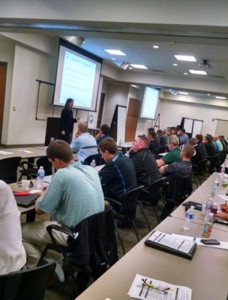From dream come true to worst nightmare
John Ramsey, superintendent at Gulf Shores (Ala.) Golf Club, went from the best-case scenario to the worst on his course.
Converting to MiniVerde bermudagrass greens was a dream come true. “It’s the best grass I’ve ever dealt with,” he says. “The greens are much more playable, you can cut at a much lower height and they withstand wear much better than our previous bermudagrass variety.”
But just like any of the newer ultradwarf varieties, MiniVerde requires constant attention. You have to be preventive in your fungicide program and extremely careful with fertility treatments, according to Ramsey. Though he first tried granular fertilizers on MiniVerde after the course was renovated in 2006, he quickly switched to completely foliar-applied products.
“The turf just responds better to foliar fertility — and you can control the growth rate much easier,” adds Ramsey, who began at the club as assistant superintendent in 2001.
Ramsey is also a believer in using humates on his greens. “I’ve applied them every year since taking over as superintendent four years ago and feel they make a huge difference in what you get out of your fertilizers,” he notes. “I think humates help the root structure and make micronutrients more available to the plant. Almost everyone who comes to this golf course brags about how good our greens are.”
Warm temperatures = more mole crickets
Despite his dream greens, Ramsey also dealt with an agronomic nightmare this summer. Even though the coastal gulf area suffered an extremely harsh winter earlier this year, temperatures overall seem to be getting warmer and warmer, says Ramsey. That means one of his worst insect problems, mole crickets, are flying in earlier and earlier each year.
“This year, we started seeing mole crickets in February,” he laments. “They are a constant problem here, as they are in most of the South. They tunnel around in the root zone, creating havoc with our fairways. Then they come out at night and leave little dirt mounds all over the surface. It’s an ugly sight.”
Timing is critical with mole cricket control. If you apply an insecticide too early, you run the risk of missing out on eggs that have yet to hatch. If you wait too long, it’s more difficult to control mature mole crickets. Ramsey monitored maturation of the mole crickets on his golf course by periodically drawing them to the surface with a mixture of water and lemon-scented dishwashing liquid.
A few months ago, Ramsey started reading about Triple Crown Golf insecticide from FMC. His distributor representative, Travis Frey, recommended he try it on tee tops and fairways, just to see how it worked. So he gave it a try, making the application over two days, July 10 and 11.
“Any time I go after mole crickets, I always use a wetting agent to help move the active ingredient down into the roots,” Ramsey explains. “I had used Dispatch Sprayable from Aquatrols for localized dry spot in the past and it worked really well. So I combined it with Triple Crown to get the product down to where the insects are feeding — in the root zone.”
Ramsey couldn’t believe how well the combination worked. “In 15 years in the business, I have never seen that many dead grubs and mole crickets!” he adds. “Within hours after the application, I saw them laying belly-up on the surface.”
Though he expects there will be a few mole crickets that escaped the treatment — and possibly another egg hatch this fall — he has seen no further activity. “Every morning since the application, I’ve driven over the fairways to see if I can detect any new activity,” he says. “So far, I haven’t seen a thing.”









